Open-ground field days workshop notes
Cimino Cole Mahurangi Action
Philip Smith Taupō Native Plant Nursery
Jaap van Dorsser Nursery consultant
David Bergin Scion Research
22–23 March 2012
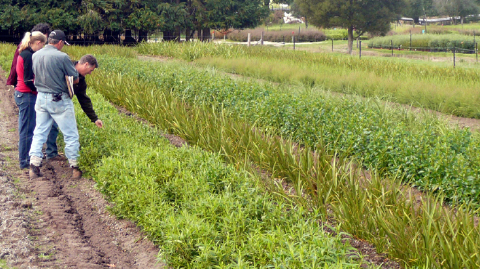
Mahurangi Plants in Taupō: Plants for the first-ever scientifically designed comparison of open-ground and container –raised indigenous plants were raised in Taupō. Taupō Native Plant Nursery has since established a nursery in the Auckland region, particularly with view to ramping-up open-ground production. photographer Michael Bergin
Introduction to the open-ground method
A considerable proportion of the pastoral land in Aotearoa, particularly riparian and marginal steep hill country, could be retired and established in indigenous species, which would improve environmental outcomes (Bergin and Cole 2010).
On some sites retired, establishing indigenous forest could provide sustainable management opportunities, integrated with agricultural land use (e.g. PCE, 2002).
However, impediments to large-scale restoration of indigenous shrubs and trees include:
- Relatively slow growth of many indigenous species
- High cost of container-raised plants
- Uneven quality of container-raised plants—potentially fatally compromised root systems
- High cost of maintenance in early years, particularly weed control.
This workshop – field days focuses on:
- The need to reduce nursery cost and improve plant quality for large-scale production of indigenous tree and shrub species, and in particular scope for using open-ground methods of propagation
- Providing an indication of early planting performance of planted indigenous trees and shrubs including a comparison of open-ground and container-raised plants of selected indigenous shrub species.
Raising indigenous species open-ground – background
From the late 1950s to the early 1980s, techniques for large-scale low-cost production of bare-rooted indigenous plants were developed at the Forest Research Institute by Jaap van Dorsser. These techniques were based on methods used for a wide range of exotic conifer and hardwood species by forest nurseries throughout the country.
The open-ground method involves highly mechanised production systems to raise and condition seedlings in readiness for planting:
- Young seedlings are lined out in 90-cm-wide nursery beds, prepared by tractor cultivation.
- Over several months preceding lifting, reciprocal undercutters are used to root-prune and wrench plants in order to stimulate the formation of compact, fibrous root systems.
- When old enough, the well-conditioned plants are easy to lift.
- Roots are inspected and trimmed before transport to the field site. Those plants with poorly developed or distorted roots are rejected.
Options for successful establishment of indigenous plants
Jaap van Dorsser
Introduction
When taking on a project of any sort, there are two options (van Dorsser 2010):
- Allow poor planning, management slop and poor execution to ruin the results, or
- Do everything well and on time.
The seasons don’t wait.
Six components contribute to the successful establishment of forest tree species, indigenous or exotic, are summarised as follows:
1 Planning and site preparation
Planning must be done well in advance. Site preparation usually involves fencing, weed spraying and animal control. Planning may have to start two years in advance of planting. Machinery may be required.
Order planting stock in advance. Giving the nursery plenty of time ensures that the species required will be available and that the quality will be satisfactory.
2 Nursery Production
Open-ground
For large-scale afforestation with indigenous species, open-ground (bare-root) production is cheaper than the raising of trees in containers.
To produce 1- and 2-year-old indigenous planting stock, the preferred method is to sow seed in plug trays during winter. Plug trays can be treated with a copper compound such as copper hydroxide. This inhibits the development of curling and tangled roots, and also has a fungicidal function. It facilitates the process of de-plugging by avoiding root damage.
Seedlings are transferred into pre-formed and pre-dibbled outdoor nursery beds in the spring. From then on the trees are ‘grown off the tractor seat’ using methods developed for exotic species such as eucalypts and Douglas-fir.
Container
The horticultural approach of single-plant culture is the prevailing method used for raising indigenous tree planting stock in Aotearoa.
In recent years some nurseries have installed cavity tray-filling and precision-sowing equipment.
This eliminates the need for pricking-out, a labour-intensive procedure that often results in tap root distortion. Cavity trays produce plug-grown plants which are then transferred into larger containers.
The inside of plug trays and containers may be treated with a copper compound such as copper hydroxide in order to improve the quality of the root systems. This treatment inhibits the development of curling and tangled roots, and also has a fungicidal function. It is especially useful for species subject to root rot problems. It facilitates removal of the plant from the container without root damage.
De-bagging
When plants are grown in planter bags the quality of their root systems cannot be readily assessed. Root deformities remain hidden until time of planting in the field, when they are not easy to rectify. For this reason, when using container-raised plants I prefer to de-bag them up to a week prior to planting. The roots are disentangled, trimmed, dipped in water and then placed in white forestry plastic bags. They must be kept wet—forgetting them at this stage is not an option.
One advantage of early de-bagging is that root system quality can be checked and remedied prior to planting. Another benefit is that it makes the establishment of a mixed species plantation much easier.
3 Transport
Robust container-grown trees are bulky and heavy. The shifting of these plants from nursery to planting site, and on the planting site itself, is costly in terms of transport and labour. Trees in white plastic bags are less bulky and lighter to handle.
4 Storage at the planting site
Bare-rooted plants must be kept cool, wet, and protected from sun, wind and frost. Laying bare root plants out ahead of planting is not an option.
5 Planting
Bare-rooted or de-bagged trees can be planted from autumn to spring—that is in the cooler and wetter parts of the year. Dig to loosen the planting spot, open up a hole wide enough and deep enough to dangle the root system in, plant deeply and firm the plant in well. Do not stuff the roots in the hole.
Water-in if necessary and possible. Assistance from the local volunteer fire brigade is an option—they enjoy the practice!
6 Aftercare
Weed control is essential, especially in the first and second years. Weed development should be monitored and if necessary controlled in the third year. Animal control is important, especially for broad-leaved species, which are particularly vulnerable to browsing. Use of animal repellents is an effective option.
Concluding remarks
When planting de-bagged plants, as described here, every tree is expected to survive and grow. Anything less than 98% success is not an option.
Taupō Native Plant Nursery open-ground production
Philip Smith
Introduction
Seedling costs and variability in plant size and quantity are currently major impediments to large-scale indigenous forestry.
Building on previous work, Taupō Native Plant Nursery is involved in collaborative nursery trials aimed at evaluating open-ground plants for a range of indigenous tree and shrub species to help reduce cost of establishment (Smith 2010).
Nursery practice for open-ground indigenous plants
An overview of nursery practice for raising open-ground indigenous seedlings:
Seed Collection and processing – Seed is collected from all over Aotearoa and from some offshore islands. It is catalogued, processed and stored either in peat or (dry) in a cool store at 4?±?1º C.
Sowing – Seed sown in seed trays for later pricking-out into plug trays, or sown manually or by machine directly into plug trays with usually 30-60 ml cavities.
Planting bed preparation – A soil test is usually necessary to get an indication of current soil fertility. Results are used as a guide for fertiliser application.
Transplanting to open-ground beds – Transplant of plugs to beds is done manually. The use of mechanical planters designed for the vegetable industry is being investigated for indigenous plants.
Plant conditioning – involves a number of critical steps performed to schedule:
- Undercutting – cutting and conditioning of tap roots
- Lateral pruning – cutting lateral root growth down the rows
- Box cutting – cutting lateral root growth between rows
- Topping – to maintain the desired root/shoot ratio
- Wrenching – to increase the amount of root fibre (root conditioning).
Pest and disease management – to date, minimal required.
Lifting – The plants receive a final wrench and anti-transpirant sprays are applied if required. Roots are dipped manually into a root-gel solution before the plants are transferred to forestry planting boxes.
Advantages of open-ground stock
There are several major advantages of open-ground plants (Smith 2010):
Lower cost of open-ground stock – current average cost of a container-grown plant varies from $2.95 for basic PB3-grade revegetation species (e.g. mānuka, pittosporum, harakeke) to $5.00 for PB3-grade podocarp tree species (e.g. rimu, matai).
Initial results from current nursery trials indicate high-quality open-ground plants can be supplied at less than half these prices.
Preliminary extrapolations indicate open-ground seedlings could be supplied at 75% less at $0.50–1.00/unit for large-scale programmes compared with $1.00 to $2.50/unit for a comparable PB3-sized plant.
Open-ground plants usually have better root structure, which can be inspected both prior to, and during dispatch. Container-grown plants are very susceptible to the root-circling and root-balling often seen in plants in the market place.
Better root–shoot ratio. Root systems generally have greater mass and more fibrous root development than container-grown plants.
Plant mass above ground can be larger—better able to survive some animal browsing.
Hardier plants—leaf cuticle thickness is noticeably thicker in open-ground plants. May confer a greater degree of disease resistance and mycorrhizal activity may be enhanced in open beds.
Disadvantages of open-ground stock
Problems associated with the raising of open-ground plants are as follows (Smith 2010):
There is a much narrower time period for planting ideally from late autumn to early spring, compared with the greater flexibility of container stock.
Bare-rooted plants have a limited ‘shelf life’ requiring cool storage protected from sun and wind and planted within two days of lifting. Modern stress guards e.g. root gels and anti-transpirant sprays can reduce the level of transplanting shock to a certain extent.
The available species range is limited. Taupō Native Plant Nursery is working to extend the number of species that can be supplied as open-ground stock.
Capital start-up costs for large-scale open-ground production is prohibitive for small operations—$50 000 for undercutter–wrencher; $70 000 for the tractor to power implements.
Good quality flat land with free draining friable soils is also required.
Further research
As this project proceeds, Taupō Native Plant Nursery has identified areas where further research is required:
- Mycorrhizal effects in the nursery and after planting in the field.
- Mechanisation of planting in the nursery and at the field site.
- Pelletising seed of indigenous species.
- Species selection – Taupō Native Plant Nursery plans to expand the current species range.
Nurse crop trials for indigenous forestry
Whitecliffs Reserve Waiau Pā
David Bergin
Introduction
A joint small-scale indigenous forestry planting trial by Franklin District Council and Scion was initiated in 1992 at Whitecliffs Reserve, Waiau Pā, South Auckland.
Focus was on demonstrating the use of artificially established nurse crops on open pastureland to provide initial shelter and the performance of interplanted indigenous conifer and hardwoods.
Trial layout and design
Trial layout comprised several single-species planted blocks of nurse crop species (Figure 1).
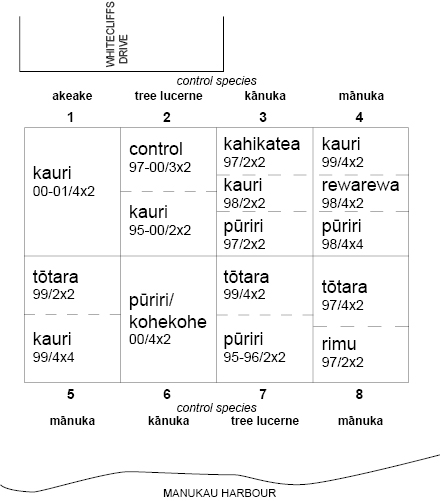
Figure 1: Indigenous forestry nurse crop planting trial layout, Whitecliffs Reserve, Waiau Pā, South Auckland. All nurse crops were planted at 2×2 m spacing, in 1992. Conifer and hardwood trees were planted from 1997 to 2001 at 2-4 m spacing as indicated. Plan Mahurangi Magazine
Nurse crops were planted at 2×2 m spacing with several species including:
- mānuka (Leptospermum scoparium) – root trainer and open-ground
- kānuka (Kunzea ericoides) – root trainer
- akeake (Dodonaea viscosa) – open-ground
- tree lucerne (Chamaecytisus palmensis) – open-ground (exotic)
Three years later (1995), tree lucerne had developed sufficient canopy for interplanting:
- kauri (Agathis australis)
- frost-sensitive pūriri (Vitex lucens)
Five years later (1998) all nurse crop species were sufficiently developed to initiate interplanting with planting of timber species completed in 2001 including tōtara, rimu, kahikatea, kohekohe, rewarewa, and further kauri and pūriri.
Results
Most successful nurse crop species, based on survival, growth and influence on the under-planted tree crop, are mānuka and kānuka (Steward and Moar 2001).
For the selected timber species most successful for survival and growth have been pūriri and totara.
Nurse crops have encouraged good form of interplanted conifers and hardwood trees, particularly rimu and totara including single leader and small branching.
Growth of interplanted trees can be severely reduced where nurse crops had over-topped and shaded trees. Regular maintenance involving thinning of nurse crops and removal of side branches to provide ‘light well’ is essential to promote growth.
Although initial establishment of tree lucerne was vigorous, within 10 years of establishment, most had died possibly due to wet heavy soils.
Pūriri interplanted three years after the tree lucerne benefited from the initial shelter of the nurse crop and with dieback of the tree lucerne has emerged through the canopy with reasonable stem form.
Conclusions
Use of nurse crops of appropriate indigenous shrub hardwoods, either planted or naturally regenerating, mimic natural regeneration processes by providing a sheltered environment for later establishment of most high forest tree species.
Provision of shelter on exposed open sites using nurse crops is essential although a few species such as kauri and totara can be planted on sheltered warm open sites as plantations without nurse cover.
For establishing indigenous trees as a long-term supply of specialty timber, nurse species encourage development of single leaders with small branching; some indigenous tree species including totara, rimu and pūriri planted at wide spacing on open sites form multiple leaders and large branches to low levels requiring intensive silviculture.
Indigenous trees with natural apical dominance such as kauri, tānekaha and kahikatea rely less on nurse crops and close plant spacing to give good form where planted on sheltered lowland sites.
Maintaining a ‘light well’ for interplanted indigenous trees is essential to encourage continued growth; thinning and pruning back nurse species is labour intensive.
Scenarios evaluating a range of planting patterns and densities including use of nurse crops and different timings of interplanting as indicated in Bergin and Gea (2007) require further research.
Open-ground and container-raised indigenous plants comparison
Sandspit Road Mahurangi catchment
Cimino Cole and David Berign
Introduction
In 2006, the organisation now known as Mahurangi Action sucessfully applied to the government’s Sustainable Farming Fund to jump-start the transfer of the nursery methods used to raise exotic forestry species, to the production of indigenous plants.
A key objective was to establish scientifically designed planting trials, in collaboration with Scion, to compare the performance of open-ground indigenous plants with standard container-grown plants.
Trials were established on three sites in the Auckland region: Two in the Weiti catchment; and one in the Mahurangi catchment—a riparian area beside Sandspit Road four kilometres east of Warkworth (Bergin and Cole 2010).
Handling and transport
Stacking of planter boxes and use of trolleys with multiple shelves allowed the following numbers of plants to be transported per square metre of truck deck space:
- open-ground (3 layers x 8 boxes x 20–40 plants) – 480-960
- PB3-sized containers (2 layers x 60 plants) – 120
- Hillson root trainers (2 layers x 6 baskets x 60 plants) – 720.
Open-ground and root trainer plants occupied similar amounts of space. Costs of handling, storage and transport were therefore also similar. In contrast, plants raised in the larger PB3 containers occupied four times as much space and transfer to the field sites was therefore more expensive.
At the planting site, handling and placement of open-ground stock was found to be easiest. Container-grown plants were heavier due to the associated growing media. Extra time was required for removal from the container.
Trial design and layout
Indigenous plants that had been raised as one of three nursery treatments at the Taupō Native Plant Nursery were compared:
- open-ground nursery beds
- PB3-sized planter bags or pots (larger-sized containers)
- Hillson-sized root trainers (small containers).
Plants of the following six indigenous species were raised by each of the three methods:
- harakeke (flax, Phormium tenax)
- karamū (Coprosma robusta)
- koromiko (Hebe stricta)
- mānuka (Leptospermum scoparium)
- tī kōuka (cabbage tree, Cordyline australis)
- toetoe (Cortaderia fulvida)
Planting trial was established on the Solway Farms riparian site alongside the Sandspit Road, Warkworth in 2008 and comprised two components (Figure 2).
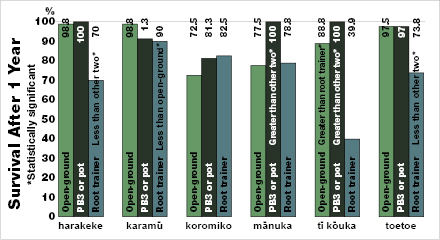
Figure 3a: Effect of three nursery plant-raising methods (open-ground, PB3-sized container, and Hillson-sized root trainer) on survival 11 months after transfer to the Sandspit Road site, Mahurangi catchment. Bars show mean values, but not standard errors. Plan Mahurangi Magazine
Larger trial blocks (replicates 1-8) comprise six species comparing three nursery raising treatments as listed above.
Smaller trial blocks (replicates 1s-4s) focused on the comparison of three different storage treatments (shade storage for 3 and 10 days and controlled cool storage for 10 days) following lifting from the nursery and before planting for two species (karamū, mānuka).
Plant spacing – 1.4 x 1.4 m (5100 stems per ha) for all replicates and all blocks with at least a single tree buffer row.
Randomised complete block design used with single nursery-raising treatment applied to each row.
Performance of field trials
All plants were assessed immediately after planting and one year later including recording survival, measurement of height, root collar diameter and crown spread, and assessment of plant vigour and health.
Plants raised as open-ground stock had in general similar survival to PB-sized stock except mānuka and tī kōuka with higher survival for PB-sized (Figure 3).
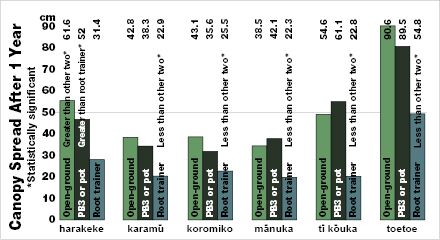
Figure 3b: Effect of three nursery plant-raising methods (open-ground, PB3-sized container, and Hillson-sized root trainer) on canopy spread 11 months after transfer to the Sandspit Road site. Plan Mahurangi Magazine
Height growth and canopy spread were similar for open-ground and PB3-sized containers after 11 months in the field (Figure 3).
Root trainers had poor survival especially for the monocots harakeke, tī kōuka and toetoe, which were difficult to find where grass growth was particularly vigorous.
A five-yearly measurement is required.
Conclusions
Early establishment performance (survival rate) of indigenous tree species was similar for plants raised in large containers (PB3 size) and in open-ground nursery beds. Higher mortality rates and slower growth can be expected in plants raised in small containers (Hillson root trainers).
Height growth was often greater in plants raised in PB3-sized containers than in those raised in open-ground beds.
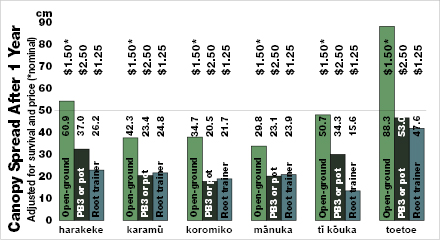
Figure 3c: Effect of three nursery plant-raising methods (open-ground, PB3-sized container, and Hillson-sized root trainer) on canopy spread adjusted for survival and price (nominal, in the case of open-ground) 11 months after transfer to the Sandspit Road site. Plan Mahurangi Magazine
Canopy spread of open-ground plants was similar or greater than that of PB3-sized plants.
The cost of plants grown in PB3-sized containers was twice that of plants grown in Hillson root trainers. Provisional estimates of cost for production of open-ground plants suggest that they are cheaper than PB3-sized plants.
Plants grown in the smaller root trainer containers or as open-ground plants were easier to handle and transport to the field sites than those in large containers.
Handling and placement at the field site was easiest with open-ground stock.
References
Bergin, D.; Cole, C. 2010: Comparisons between open-ground and container-raised indigenous shrubs in nursery and field trials. In: Barton, I.; Gadgil, R.; Bergin, D. (Eds.) Managing native trees. Towards a national strategy. Proceedings of the Tāne’s Tree Trust 10th Anniversary Conference and Workshop, University of Waikato 18-20 November 2009. 64-74.
Bergin, D.O.; Gea, L. 2005 (revised edition 2007): Native trees – planting and early management for wood production. New Zealand Indigenous Tree Bulletin No. 3. New Zealand Forest Research Institute. 44p.
Smith, P. 2010: Reducing costs associated with establishment of native plants in the Lake Taupō Catchment. In: Barton, I.; Gadgil, R.; Bergin, D. (Eds.) Managing native trees. Towards a national strategy. Proceedings of the Tāne’s Tree Trust 10th Anniversary Conference and Workshop, University of Waikato 18-20 November 2009. 52-55.
Steward, G.; Moar, A. 2001: Performance of indigenous plantations, Whitecliffs Reserve. Unpublished Report. Forest Research and Franklin District Council. 19p.
Van Dorsser, J. 2010: Options for successful establishment of natives. In: Barton, I.; Gadgil, R.; Bergin, D. (Eds.) Managing native trees. Towards a national strategy. Proceedings of the Tāne’s Tree Trust 10th Anniversary Conference and Workshop, University of Waikato 18-20 November 2009. 56-57.
See also Open-Ground Indigenous Plants Report
